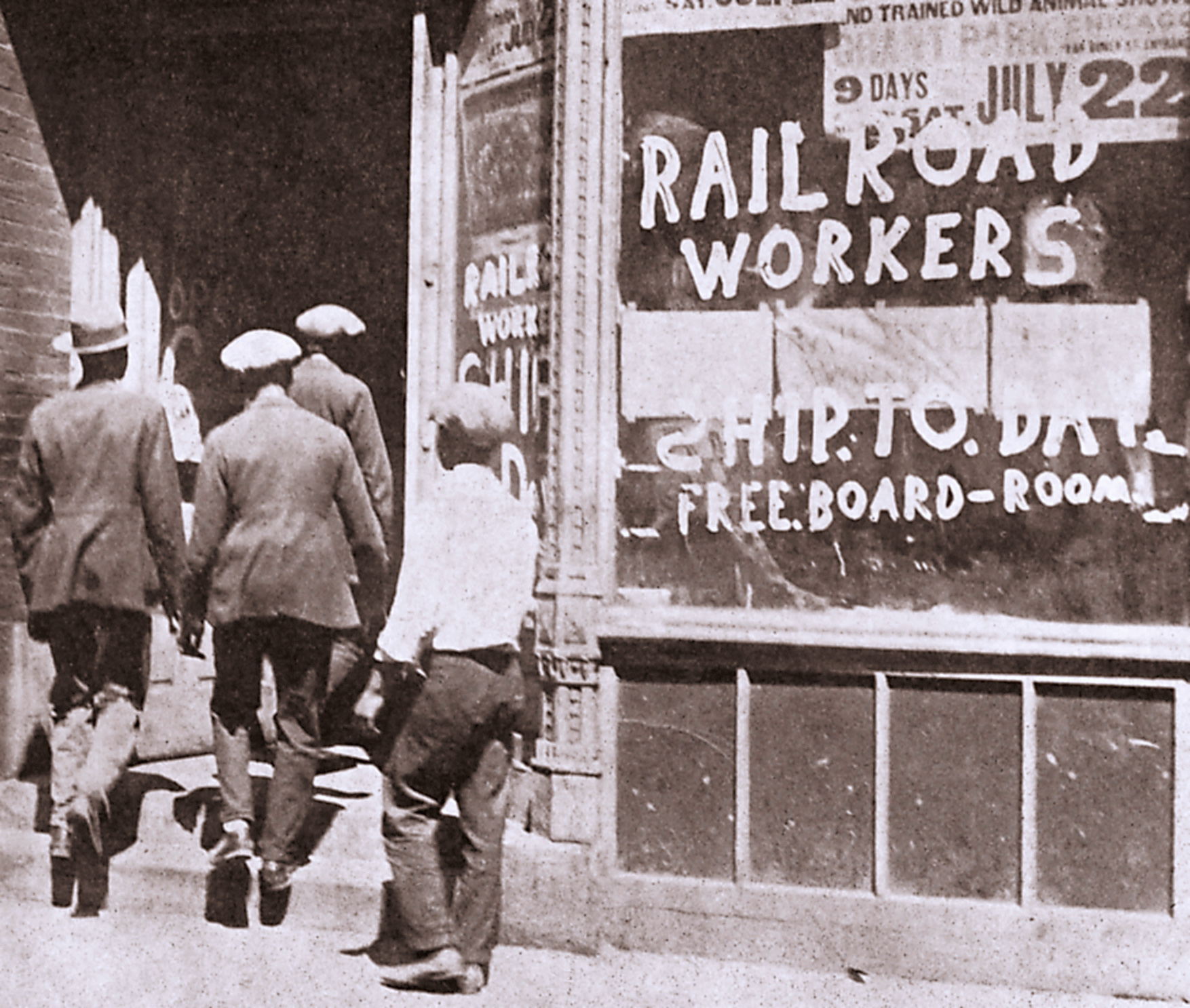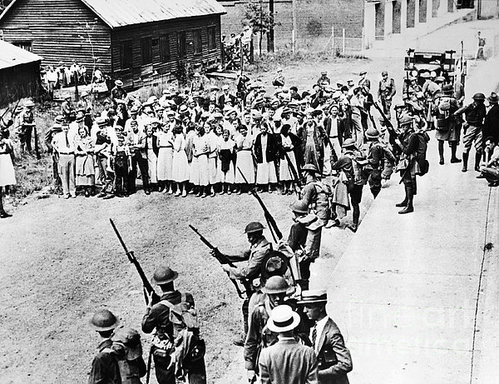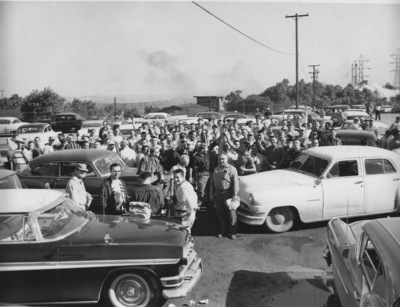1) Great Southwest Railroad Strike
*March-September 1886
*Arkansas, Illinois, Kansas, Missouri, and Texas
By the end of the 1800’s, the American railroad was expanding quickly. In 1886, the Knights of Labor struck against the Union Pacific and Missouri Pacific railroads, owned by robber baron Jay Gould. Hundreds of thousands of workers across five states refused to work, citing unsafe conditions and unfair hours and pay. The strike suffered from a lack of commitment from other railroad unions, the successful hiring of non-union workers by Gould, violence and scare tactics. Eventually, the strike failed, and the Knights of Labor disbanded soon afterwards.
2) The Pullman Strike
*250,000 strikers
*May 11 to Mid-July, 1894
*Centered in Chicago, Illinois
Facing 12-hour work days and cut wages resulting from the depressed economy, factory workers at the Pullman Palace Car Company walked out in protest. The workers were soon joined by members of the American Railway Union (ARU) who refused to work on or run any trains, which included Pullman-owned cars. Soon enough, 250,000 industry workers joined in the strike, effectively shutting down train traffic to the west of Chicago. The strike ended when President Grover Cleveland sent federal troops to Chicago on July 6, 1894. However, widespread sympathy for the workers’ cause promoted pro-union sentiment across many areas of the country.
3) Great Anthracite Coal Strike
*147,000 strikers
*May- October, 1902
*Place: Eastern Pennsylvania
At the turn of the last century, the United Mine Workers of America began a strike which threatened to create an energy crisis. Seeking better wages and conditions, The UMWA struck in eastern Pennsylvania, an area that contained the majority of the nation’s supply of Anthracite coal . As the winter of 1903 approached President Theodore Roosevelt became concerned that a heating crisis could develop and attempted to intervene – unsuccessfully. Industrialist and financier J.P. Morgan believed the strike could threaten his businesses and made a deal with the union. The UMWA’s initial demands were for a 20% wage increase. They wound up with a 10% raise.
4) Steel Strike of 1919
*350,000 strikers
*Sept 22, 1919 to January 8, 1920
*Pittsburgh, Pennsylvania
Following World War I, workers represented by the American Federation of Labor (AFL) organized a strike against the United States Steel Corporation as a result of poor working conditions, long hours, low wages, and corporate harassment regarding union involvement. The number of strikers quickly grew to 350,000, shutting down nearly half of the steel industry. Company owners, however, invoked public concerns over Communism and immigration as a way of turning public sentiment against the unions, resulting in the strike’s failure and ensuring an absence of union organization in the steel industry for the next fifteen years.
5) Railroad Shop Workers Strike of 1922
* July-October, 1922
* Nationwide
In 1922, the railroad labor board announced that wages for railroad shop workers would be cut by seven cents – a considerable sum at the time. In early July of that year, 400,000 rail shop laborers from a conglomeration of unions went on strike. The great American railroads responded, immediately employing non-union workers to replace three-quarters of the empty positions. After the strike had lasted for some time, U.S. Attorney General Harry Daugherty persuaded a federal judge to ban all strike-related activities. The unions knew the ban put an end to their efforts and settled in October for a 5 cent pay cut and went back to work.
6) Textile Workers Strike of 1934
*September 1, 1934 to September 23, 1934
*Entire Eastern Seaboard
On Labor Day in 1934, after years of long hours and low wages, American textile workers set out on strike, in response to the negligent representation of textile labor in FDR’s National Recovery Administration. The United Textile Workers (UTW) organized 400,000 to walk out for just over twenty days, but a lack of outside support and an excess of textile materials, especially in the Southern states, forced the strike to end without any of the original demands being met. Union spirit reached new lows in the following years and many workers were blacklisted as a result.
7) 1946 Bituminous Coal Strike
*400,000 strikers
*April-December, 1946
*Across 26 States
On April Fools day of 1946, the United Mine Workers of America called on 400,000 bituminous coal miners to strike for safer conditions, health benefits, and pay. The strike came at a time when the national economy was recovering from the second World War, and president Truman saw the UMWA’s actions as counterproductive to national industrial recovery. Truman approached the union with a settlement. When the workers refused the proposal, they were fined $3.5 million, forcing their agreement and the end of the strike. Although forced, most of the UMWA’s demands were met in Truman’s compromise.
8 ) Steel Strike of 1959
*July 15, 1959 to November 6, 1959
*Nationwide
During 1959, steel industry profits were skyrocketing. Noticing this, the nation’s steelworkers, represented by the United Steelworkers of America, demanded higher wages. At the same time, management was working against the union to lose a contract clause which protected worker jobs and hours. This conflict resulted in a 500,000 worker strike the effects of which were felt throughout the industry. In the end, the union received wage increases and preserved their contract clause.
9) 1970 U.S. Postal Strike
*Two weeks in March, 1970
*Began in New York City, Spread Nationwide
During the Nixon Administration, U.S. postal workers were not allowed to engage in collective bargaining. Increased dissatisfaction with wages, working conditions, benefits, and management led the postal workers in New York City to strike. Encouraged by New York’s example, postal workers nationwide followed suit. With mail and parcel delivery at a standstill, Nixon ordered the National Guard to replace the striking workers – a measure which proved ineffective. The strike was so effective that within two weeks negotiations took place. The unions’ demands for wages and conditions were largely met, and they were granted the right to negotiate.
10) UPS workers strike
*August 4, 1997 to August 19, 1997
*Nationwide
The largest strike of the 1990’s was lead by 185,000 UPS Teamsters. They were looking for the creation of full-time jobs rather than part-time, increased wages, and the retention of their multi-employer pension plan. These workers gained major support from the public and eventually had all of their demands met. UPS, however, lost more than $600 million in business as a result of the ordeal.
Resource: 24/7WallSt.com
-Michael B. Sauter, Charles B. Stockdale, and Douglas A. McIntyre
To read more about US labor history, beginning in 1607, click here.
To read more about US labor history, beginning in 1607, click here.












0 comments:
Post a Comment